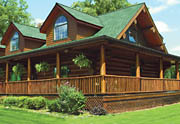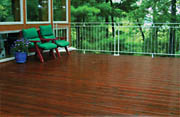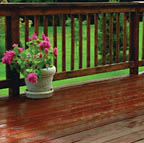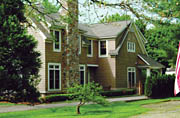Inside What Goes On Outside

When architects and builders design a home or an office, they not only need to consider local codes and regulations, but also how their creation will endure the environmental elements over time. Otherwise the beautiful structure they began with can quickly deteriorate, not only visually but structurally as well. Therefore, architects and builders go to considerable lengths to select just the right wood and building materials.
Today's market presents many choices in coatings for wood. The raw material choice, water resistance, UV protection and durability of a coating should be matched to its intended purpose. Differences in quality can affect the durability and performance you get from products of the same resin structure. Whether the resin used is an alkyd, acrylic or another designation, it is important to realize that these resins can vary considerably in their quality due to the materials, as well as the techniques used to manufacture them. Choosing a higher-quality coating can help avert expensive maintenance and future repairs.

Raw Material and Coating Development
The R&D departments of coatings manufacturers test the quality of thousands of raw materials and the methods by which they can be mixed or applied. The performance of a particular coating depends on the actual materials employed, not just on the technology of combining them. For instance, clay can impact a paint's rheology. Clay mined from various spots on the globe will contain different substances. Some clay is suitable for waterborne paint and can be swollen with water (volclay, sodium bentonite, platelet shape). Other clay types are more appropriate for solventborne paint and can be swollen with solvents (bentone, hectorite, platelet structure).
Inert pigments, often called filler pigments, are not all created equal. Fillers are mostly used to occupy volume in a film and reduce the cost of a coating, but they can also impart other desirable qualities. Rheology, gloss and sandability are all attributes that are affected by these inert pigments. For example, calcium carbonate - a commonly used filler - is available in many different grades, with trace differences from various mines that can make a big difference in the coating's performance. Calcium carbonate may react with acid rain to produce frosting on a dark-colored coating. Many fillers also can contribute to chalking, especially if the formulation exceeds the critical pigment volume concentration (CPVC). That's why the choice to use or exclude filler pigments largely depends on the final purpose of the coating.

Lab Materials for Specialized Needs
Where coatings manufacturers differ often is in the proprietary resins they develop. For instance, instead of adding a UV absorber after the resin is produced, in some products Sikkens uses UV absorbers that are incorporated directly into the backbone of the resin, resulting in much longer UV protection.
A key aspect of resin development is the testing to ensure resistance to the elements. Sikkens tests its proprietary resins in the Alps and numerous other locations in Europe (Italy, Sweden etc.) with severe weather conditions and high levels of UV rays, plus extreme temperature fluctuations to indicate clearly how a resin will perform over time. Additionally, in North America, hot-weather and cold-climate test sites in Florida, Arizona and Michigan enable chemists to determine the amount of protection a specific formulation offers against deterioration. These real-world test applications help verify lab tests and fine tune the final formulations better than lab test methods alone. Akzo Nobel is a leader in innovative high solids technology, with much of the work being done in highly specialized labs in the Netherlands.

Cost Considerations in Evaluating Quality
It is not always what is in the formulation that must be considered, but also what is left out. The best coatings use fewer fillers and contain more binders. The latest coatings have high solids content for more durable coverage. While low-cost paints and stains may contain, for example, 20-percent solids, a higher-priced coating might be 70-percent solids. The content of the coating that is not solid eventually evaporates. Therefore, a coating with 20-percent solids leaves only one-fifth of the mixture remaining on the surface. This again emphasizes the importance of considering product properties and content to ensure successful performance.
Another consideration is the price of practical application i.e., the high price of labor. Selecting a high-solids coating can lead to fewer coats, thus reducing labor, which usually far exceeds the price of the materials. Moreover, higher-quality coatings that offer longer-term protection against moisture, temperature variances and UV rays can ensure a project stays in top shape with little maintenance for years, instead of just months.

Substrate Variations
Just as coatings evolve, so do the uses of the woods and other building materials that they are called on to cover. For example, the current popularity of exotic woods, such as super-dense ipe (which sinks in water), raises new challenges. Non-porous woods like this are much harder to coat, yet they are dimensionally stable and do not absorb water and, therefore, a stain that forms a film on top of the wood can produce an effective finish.
Not only are the choices of wood changing, but so are the ways wood is treated. The chromated copper arsenate (CCA) formerly used in pressure-treated woods has been replaced with amine copper quat (ACQ) and copper azole. As a consequence, coating materials must be adapted to ensure proper adhesion and to consider color changes and variations in durability that can be caused by these new compounds. CCA, ACQ and copper azole affect coatings differently, so Sikkens works hard to ensure that it has adequately tested its coatings on all types of wood substrates both weathered and new.
Changes from Challenges
Other challenges to paint manufacturers have emerged from regulations imposed by the EPA, and state and local agencies. VOC rules lead the list of challenges. A national regulation covering volatile organic compounds (AIM) is currently in effect, but regional governments all across the United States are adopting more restrictive rules, which vary significantly among states and even among counties within a state. Some of the coatings produced by manufacturers today are designed to be sold only in specific geographic areas to meet local requirements.The biggest question confronting these manufacturers is how to keep the same properties of existing coatings but make them lower in VOC. The answer is usually either make the product a high solid or switch to a waterborne coating. Recent formula variations include an alkyd in water, a cold-blend alkyd/ acrylic system or a hybrid acrylic-modified alkyd. Even though many manufacturers are turning to waterborne coatings because of VOC regulations, dealers should maintain a good balance of the newer formulations that use alkyd/oil technology for projects that require high levels of durability and moisture resistance.
While coatings may look alike sitting on the shelf, the differences within them are crucial to a successful coating project. The quality of the resins and other materials blended into the paint or stain determine the level of its durability, avoidance of peeling and cracking, UV and fading resistance, and water repellency. All of the laboratory procedures, weather testing and practical applications coating manufacturers employ in the development of coatings have led to newer and better-performing products. Selecting the right coating for the job and considering the total cost of the project over its lifetime will help assure an affordable wood coating that remains attractive, structurally sound and useful.
Looking for a reprint of this article?
From high-res PDFs to custom plaques, order your copy today!







